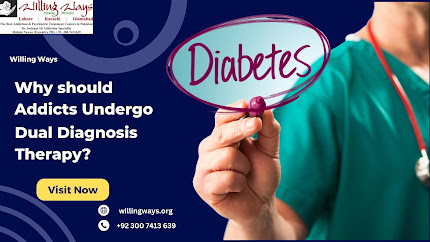What is Depression and Bipolar Disorder?
Willing Ways Lahore is the best addiction treatment center in Lahore. We have experienced staff to take care of your dear ones. You can contact our rehabilitation center anytime, Our rehab is 24/7 open and also available on google.
According to the DSM-IV, mood disturbance consists of two symptoms: (1) depressed mood (feeling sad, blue, or down in the dumps), also known as dysphoria, and (2) lack of interest or pleasure in almost all activities most of the day, also known as anhedonia.
To be diagnosed with major depression, a person must experience at least five depressive symptoms from the following list, including at least one of the two hallmark features of depression-depressed mood and loss of interest. These symptoms must be present most of the day nearly every day for at least two weeks:
1. Depressed mood
2. Loss of interest
3. Significant weight loss or gain
4. Trouble sleeping or sleeping too much
5. Restless feelings and inability to sit still or slow down
7. Fatigue, loss of energy, or tired all the time
8. Worthless or guilty feelings
10. Impaired concentration and difficulty making decisions
To be classified as indicative of major depression, these symptoms must cause significant distress or impairment in social, occupational, and other important areas of functioning. Furthermore, the formal diagnosis must rule out other medical causes of depressed mood, including medication effects, substance abuse, or general (i.e., other than psychiatric) medical condition such as hypothyroidism. Finally, the symptoms should be distinguished from those of grief or bereavement associated with loss of a loved one or extraordinary distress.
Bipolar Disorders
Bipolar disorders are episodic conditions characterized by at least one episode of mania (extreme highs) or hypomania (moderate highs). The large majority of people who experience manic episodes also experience recurrent episodes of major depression. Others experience dysthymia.Cycling between the poles of high-high (mania) and low-low (depression) is the very essence of the diagnosis of bipolar disorder, which contrasts with major and mild-to-moderate depression-disorders characterized by lows without intervening manic highs (hence the name unipolar depression used sometimes for depression).
To be diagnosed as having a manic episode, a person must experience manic symptoms-feeling unusually high, euphoric, elevated, or expansive-for at least one week and also experience three or more of the following symptoms:
1. inflated self-esteem and grandiosity
2. marked decrease in the need for sleep
3. talkative with rapid, pressured speech
4. flight of ideas (rapidly racing thoughts)
5. distractibility
6. increase in goal-directed activity
7. excessive involvement in pleasurable activity with a high risk of painful consequences (buying sprees, sexual indiscretions, or foolish investments)
Three types of bipolar disorder are distinguished based on the degree of cycling:
Bipolar I disorder involves one or more manic episodes along with multiple major depression episodes. Thus, cycling is the most extreme, ranging from high-high to low-low.Bipolar II disorder involves hypomanic (medium-high) episodes cycling with multiple major depression episodes. Cycling is between medium-high and low-low.
Cyclothymia involves multiple episodes of hypomania cycling with multiple episodes of mild-to-moderate depression (dysthymia). Cycling is between medium-high and medium-low.




Comments
Post a Comment